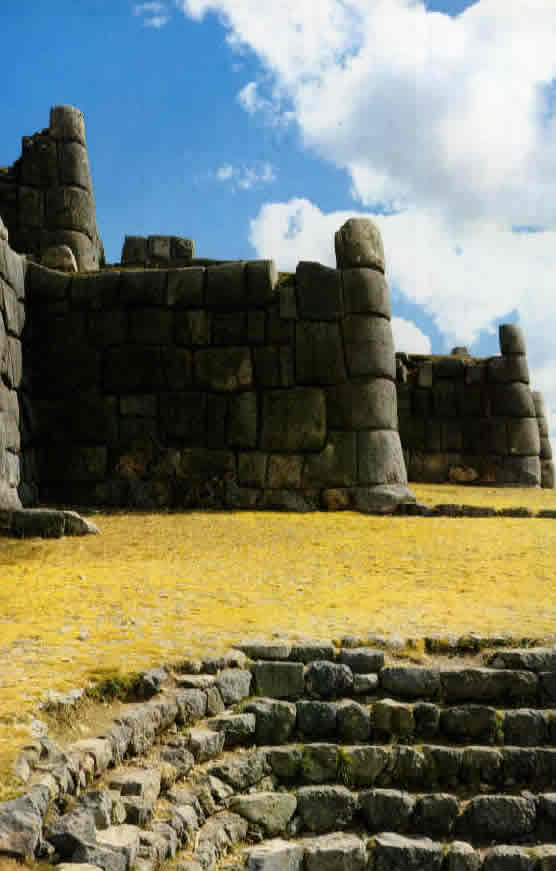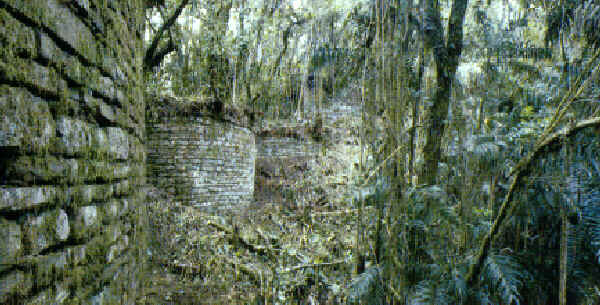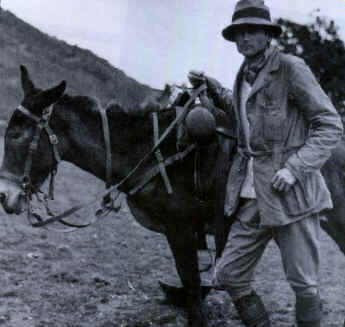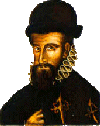|
Documentaries
Press
|
Rated 1.57/5
|
The Conquest of the Inca Empire
Part 3
X an endless hunger for power
Pizarro listened to the proposal and thought that Atahualpa had become crazy. But after some days he started to believe that the Inca was serious and the deal was written on paper. Then the gold and silver started to arrive. Vases, golden goblets, 700 golden plates from the temples of Cuzco, idol pictures, golden birds, replicas of all forms and animals, etc.. A witness said that 200 cargos of gold arrived, each carried by 4 men. One freight even had be carried by twelve men. The Spanish couldn't believe their eyes and started to wonder what more was there to be found in Cusco, they had to wait a year more to find out. Instead of releasing Atahualpa they held him into capitivity in the hope to get more gold and silver.
 The
Sapa Inca understood that he had signed his own death sentence, although he kept
his word. Again he had underestimated the invaders. He
could never know that their hunger for gold could be so enormous. Woven textile
has more value for the Inca's, seen the number of hours of labor needed for its production.
He feared also that his brother, still in jail in Cusco, would try to make a deal
for his freedom and secretly he demanded that he, his sister and his mother to be
assassinated, what also happened shortly after.
The
Sapa Inca understood that he had signed his own death sentence, although he kept
his word. Again he had underestimated the invaders. He
could never know that their hunger for gold could be so enormous. Woven textile
has more value for the Inca's, seen the number of hours of labor needed for its production.
He feared also that his brother, still in jail in Cusco, would try to make a deal
for his freedom and secretly he demanded that he, his sister and his mother to be
assassinated, what also happened shortly after.
 Pizarro
and his men received in total 5,000 kilogrammes gold and 9,700 kilogrammes silver.
It was agreed that all randsom would be shared under each other while Atahualpa was
still in captivity. As everthing was received with Atahualpa was still alive, it
was seen as randsom, a new problem arrised. Newcomers, attracted by the tales of
mountains of gold had accompanied the present Spanish.
They only got a fraction of the gold. They forged a plan and spread the rumour
that the army of Atahualpa prepared an attack on the numerically weak
Spanish, hoping to get a better share in the future. Fear grabbed into the hearts
of Pizarro's men and they decided to assassinate the Inca. Atahualpa was well aware
of the plot against him and started to make preparations to become immortal. To this
he needed to be embalmed and oiled as wat happend to his ancestors.
Pizarro
and his men received in total 5,000 kilogrammes gold and 9,700 kilogrammes silver.
It was agreed that all randsom would be shared under each other while Atahualpa was
still in captivity. As everthing was received with Atahualpa was still alive, it
was seen as randsom, a new problem arrised. Newcomers, attracted by the tales of
mountains of gold had accompanied the present Spanish.
They only got a fraction of the gold. They forged a plan and spread the rumour
that the army of Atahualpa prepared an attack on the numerically weak
Spanish, hoping to get a better share in the future. Fear grabbed into the hearts
of Pizarro's men and they decided to assassinate the Inca. Atahualpa was well aware
of the plot against him and started to make preparations to become immortal. To this
he needed to be embalmed and oiled as wat happend to his ancestors.
Pizarro, who didn't want to take any rash decisions, did eventually agree to get rid of Atahualpa. In an improvised Council which presented a court, the final decision came that Atahualpa would be brought to death on a stake. When he heard the news, he was overcome with grieve. Combustion would mean that his body can no longer be mummified and that an eternal life according to the believes of the Inca's would no longer possible. Tied on the stake, a priest tried to convert him to christianism. The Inca understood that as a convert he would be brought to death by strangulation, so his body would still be able to be mummified. He agreed to be converted, was baptised and finally strangled. As a last action of treason the Spanish burned the clothes and body of the death Sapa Inca partially. Afterwards they have buried in the Christian way with so much splendour "as if he was the most important Spaniard", said one of the conquistadores later.
XI an inglorious end
Pizarro realised the advantage of having an Inca leader in captivity and decided to capture Manco Capac, who stayed in Cusco. He was still a living son of Huayna Capac and therefore the son of Huascar whom he supported during the war against Atahualpa. Manco Capac was beloved by his people and Pizarro reconned that they would follow the 'will' of this Inca. The Incas took no risks and when the Spanish approached Cuzco all wealth had been hidden on a secret location. Also their largest possession, their mummified ancestors, had been safely hidden.
 At
their entrance in Cuzco, the Spanish were welcomed as the guards of Inca-regime.
The leaders should preserve their
title and dignity, provided that they agree with obedience to the Inca-governor
in their area. However, Pizarro showed absolutely no respect for any Inca-habit.
On the contrary Pizarro left Cuzco to found a new capital: Lima
. Gonzalo and Juan, two brothers of Pizarro, got the command of Cuzco. They
acted with the lowest respect for the local people.
At
their entrance in Cuzco, the Spanish were welcomed as the guards of Inca-regime.
The leaders should preserve their
title and dignity, provided that they agree with obedience to the Inca-governor
in their area. However, Pizarro showed absolutely no respect for any Inca-habit.
On the contrary Pizarro left Cuzco to found a new capital: Lima
. Gonzalo and Juan, two brothers of Pizarro, got the command of Cuzco. They
acted with the lowest respect for the local people.
When Manco heard about the lack of respect of the Spanish and the many cruelties that took place by them in the country, he refused further collaboration. He tried to escape Cuzco but was caught and imprisoned in Cusco.
Gonzalo left Cusco and went on a mission to take revenge on the assassination of some of his compatriots ( ...) Hernando (also a brother of Pizarro) was left in Cusco. Manco Capac told him that he wanted to pray at a huge golden statue of of his ancestors and Hernando would be given the statue as a present afterwards. Hernando believed the story and released Manco. Outside Cuzco he called on the still residual compatriots to start an insurrection. Tiens of thousands of them joint Manco and they formed an army. At last the Inca's had a leader and could start a counter-attackt. The new army occupied Cuzco. Pizarro was shortly after informed by this alarming news.
The siege would last almost a year, during which Cuzco was entirely cut off the outside world. A bloody battle that took two weeks at the fortress of Sacsahuamán was won by the Spanish. The conquistadores were in secret provided with food by Indian collaborators who deceived the emperor earlier by promising their support to the Spanish and feared for their lifes if the Inca's could get to power again. When fresh Spanish troops arrived the men of Manco lost all will to continue this battle and flet the scene.
In fact, many people in the former empire of the Incas lost their will to live on. The number of inhabitants of Tihuantinsuyu had been pushed back in less than half a century from an estimate 7 million to less than 500,000 . Those who survived the variola epidemic, died by forced labour imposed by the Spanish at dragging cargo from the coast region to the high lands or by working in the silver and gold mines.
XII the last remainders of gloryA small number of Inca's continued to fight and build a new city deep in the rain forrest, the one that Hirma Bingham looked for when finding Machu Picchu. Vilcabamba, this new city, covered an area of 5 square km. Within limited time 300 stone and 60 monument buildings were constructed. A 35 years long guerrilla war was conducted against the Spanish outposts.

In 1572 the Spanish decided to get rid of Vilcabamba, the last basis of power of the Incas. The remaining Incas has, before the arrival of the Spanish, torched their own city and fled into the rain forest. The conquistadores began a pursue. Deepl in the jungle the last Sapa Inca, Tupac Amaru fell in their hands. In Cuzco he was decapitated after a sham process, the Inca-dynasty disappeared for once and for all.
Vilcabamba, deep in the jungle which its temples and houses was forgotten and was overgrown entirely untill the discovery of Hiram Bingham in 1911. Now it is only visited by archeologists. They try to reconstruct the last days of the last Inca, but the rain forest does not give up its mysteries, the last remain of an empire remain in silence. No wonder that the farmers close to Vilcabamba call the place el Espíritu pampa or "plain of spirits".
Meanwhile, the Spanish occupied themselves with profaning the many temples of the Sun and palaces. Almost all found gold disappeared in the melting furnaces and transported to Spain. A few remaining artifacts where displayed in Sevilla. When the Spanish king Karel V came in need for mony as a result of the many wars fought by Spain, these noble objects werre also melted into inexpressive gold bars.

The American discovery traveller professor Hiram Bingham
| The end of an empire
External links
|
|
|
©2024 InfoPeru Best 1024 x 768 |
| Top | Cities | Machu Picchu | Inti Ramyi | Inca Trail | Incas | Email | Sitemap | About |
38688 visits
